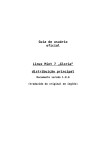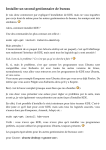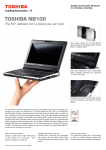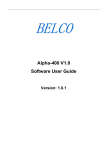Download Foxconn NetBox-N270
Transcript
QBOX User’s Manual Trademark: All trademarks are the property of their respective owners. Version: User’s Manual V1.1 for QBOX-N270. P/N: 3A221LE00-000-G CA UT IO N Symbol description: ! Caution : refers to important information that can help you to use QBOX better, and tells you how to avoid problems. WEEE: The use of this symbol indicates that this product may not be treated as household waste. By ensuring this product is disposed of correctly, you will help prevent potential negative consequences for the environment and human health, which could otherwise be caused by inappropriate waste handling of this product. For more detailed information about recycling of this product, please contact your local city office, your household waste disposal service or the shop where you purchased this product. © All rights reserved. All trade names are registered trademarks of respective manufacturers listed. All images are for reference only, please refer to the physical product for specific features. CA UT IO N Safety Notice : ! Before using this product, please read the below safety notice carefully, this will help to extend the product’s lifecycle, and work normally. ■ When QBOX is working, please make sure its ventilation system is working. ■ The power adapter is dissipating heat during normal use, please be sure not to cover it and keep it away from your body to prevent discomfort or injury by heat exposure. ■ Please use the power adapter that comes with the product’s package, wrong power adapter may damage your device. ■ Make sure all the peripherals are properly connected before using QBOX. ■ This product should only be used in an environment with ambient temperatures between 0◦C and 40◦C. ■ To reduce the risk of fire, use only No. 26 AWG or larger UL listed or CSA certified telecommunication line cord. ■ Always shut down the computer before installing or uninstalling the peripheral which does not support hot plug. ■ Disconnect all peripherals before servicing or disassembling this equipment. ■ Please do not disassemble this product by yourself, any disassembly not approved by the original manufacturer may result in malfunction, and void warranty. ■ Risk of explosion if battery is replaced by an incorrect type, please dispose of used batteries according to the instructions. Table of Contents Chapter 1 Introducing the QBOX Top View....................................................................................................2 Left Side View...........................................................................................2 Right Side View.........................................................................................3 Bottom View..............................................................................................3 Chapter 2 Placing and connecting the QBOX Placement of QBOX..................................................................................5 Connection of QBOX.................................................................................7 Chapter 3 Install Windows XP in QBOX Install Windows XP..................................................................................10 Install Drivers in Windows XP.................................................................13 Chapter 4 FoxOS Introduction First Boot.................................................................................................15 Desktop...................................................................................................17 Desktop Shortcut.....................................................................................18 Chinese keyboard Input Mode................................................................19 Network Connection................................................................................19 Chapter 5 Applications Internet....................................................................................................23 Office Applications...................................................................................24 Education and Learning..........................................................................26 Multimedia Applications...........................................................................26 Other Applications...................................................................................28 The QBOX is a compact and easy to use desktop. It features all the desktop capabilities but with a slim body design which enables you to browse the internet in a relax and comfortable way. This chapter includes the following information: ■ Top View ■ Left Side View ■ Right Side View ■ Bottom View 1 QBOX features all the desktop capabilities but with a slim body design which enables you to browse the internet in a relax and comfortable way. 1-1 Top View 1 2 No. Name Description 1 Power Button Turning the power on/off 2 Computer Status Indicators From left to right: Num Lock Indicator Caps Lock Indicator Wireless Network Indicator 1-2 Left Side View 1 2 3 4 5 6 No. Name Description 1 Outlet Vents QBOX's ventilation system outlet 2 Power Input Port Connects to the power adapter 3 Display Output Port (VGA) Connects to display device 4 USB Port Connects to USB device 5 Microphone In Connects to a microphone 6 Headphone Out Connects to a headphone or amplified speaker 1-3 Right Side View 1 2 1 3 4 5 No. Name Description 1 Card Reader Supports MMC/SD/MS memory cards 2 USB Port Connects to USB device 3 Modem Port (optional) Connects to a telephone line 4 Network Port Standard RJ-45 network port 5 Kensington® Lock Slot Connects to a security lock that prevent the QBOX to be removed from a fixed object 1-4 Bottom View 1 2 No. Name Description 1 Base Cushion Seat and protect QBOX when it is placed on the desk 2 Inlet Vents QBOX's ventilation inlet In this chapter, the placement and the connection of some necessary peripherals will be introduced. This chapter includes the following information: ■ Placement of QBOX ■ Connection of QBOX 2-1 Placement of QBOX 1. On the Desk If there is enough space on your desk, you can simply put your QBOX on the tabletop as shown below. 2 2. Under the Display If you want to save the space on your desk, you can : 2.1 Adjust and fit the QBOX body into the bracket as shown. 2.2 Place the whole unit under the LCD. 3. On the Display Back 2 This is the best space-saving way. 3.1 Use four screws come with the packaging to fasten the bracket onto the display back. The diameter of screw is 4mm, and the length is 12mm. CA UT IO N 3.2 Fit the QBOX into the bracket with power button locating at the bottom for easy touch. ! To install the bracket, your display must follow VESA75/VESA100 standard. The bracket supports many holes to help you easily fasten it onto the display. 2-2 Connection of QBOX 1. Connect the Monitor Connect one end of the VGA cable to QBOX, and connect the other end to a monitor. 2 2. Connect the USB Devices Connect USB devices to the USB ports of the QBOX, for example, mouse and keyboard. 3. Connect the Network Cable If you want to access the network, there are two options : 3.1 Connect LAN cable to the RJ-45 port, with the other end connected to a hub or switch. Hub or Switch RJ-45 Cable 3.2 Connect the telephone line to the RJ-11 port. Use internal Modem to access the Internet. 2 Line Outlet Telephone Line 4. Connect the Power Cord Connect the power adapter to QBOX, and push the power button to start it. 2 Outlet 3 CA UT IO N 1 ! The power adapter is dissipating heat during normal use, please make sure not to cover it and keep it away from your body to prevent discomfort or injury from heat exposure. This chapter introduces the Windows installation : ■ Install Windows XP ■ Install Drivers in Windows XP Make sure you have these ready : 1. An external USB DVD-ROM drive. (Other purchase) 2. QBOX driver CD. (In this package) 3. Windows XP Install CD. (Other purchase) 3 Before we continue : ■ ■ Your QBOX power is off. Connect the USB DVD-ROM drive to one USB port of QBOX and power it on. 3-1 Install Windows XP 1. Push power on button to turn on your computer, then press <DEL> key to enter BIOS Setup. 2. Put the Windows XP Install CD into the USB DVD-ROM drive. 3. Select and go to the “Boot” menu, set the “1st Boot Device” to “USB: Optical DVD RW”, press <F10> key to save change and exit BIOS. BIOS SETUP UTILITY Main Advanced Security Boot Exit Boot Settings Specifies the boot sequence from the Quick Boot [Enabled] available devices. Quiet Boot [Disabled] A device enclosed in Onboard LAN Boot ROM [Disabled] parenthesis has been disabled in the Boot Device Priority corresponding type 1st Boot Device [USB:Optical DVD RW] menu. 2nd Boot Device [HDD:PM-FUJITSU MHZ] 3rd Boot Device [USB:Generic- SD/MM] [Network] 4th Boot Device ←→ Select Screen [USB:Generic- SD/MM] ↑↓ Select Item 1st Removable Drive 2nd Removable Drive [USB:Generic- MS/MS] +- Change Field F1 General Help 1st Hard Disk Drive [HDD:PM-FUJITSU MHZ] F7 Discard Changes [USB: Optical DVD RW] F10 Save and Exit 1st CD/DVD Drive ESC Exit v02.61 (C)Copyright 1985-2006, American Megatrends, Inc. 10 4. The computer will reboot, and it will start installing Windows XP Operating System. Windows XP Professional Setup Welcome to Setup. This portion of the Setup program prepares Microsoft(R) Windows(R) XP to run on your computer. ● To set up Windows XP now, press ENTER. ● To repair a Windows XP installation using Recovery Console, press R. ● To quit Setup without installing Windows XP, press F3. ENTER=Continue R=Repair F3=Quit 5. Press <ENTER> key to continue the installation. 6. Press <F8> key to accept the Licensing Agreement and continue. 7. Windows will display the hard disk partitions (160GB, in this example) of your system. If previously there were other systems (such as Linux) installed, you may need to press [D] key to delete them. When all partitions are clean, Setup will display the biggest size of your hard drive as depicted in step 8. Windows XP Professional Setup The following list shows the existing partitions and unpartitioned space on this computer. Use the UP ad DOWN ARROW keys to select an item in the list. ● To set up Windows XP on the selected item, press ENTER. ● To create a partition in the unpartitioned space, press C. ● To delete the selected partitions, press D. 152626 MB Disk 0 at Id 0 on bus 0 on atapi [MBR] F: Partition1 [Unknown] G: Partition2 [Unknown] Unknown Disk <There is no disk in this drive.> Unknown Disk <There is no disk in this drive.> ENTER=Install D=Delete Partition 150868 MB < 150868 MB free> 1757 MB <1757 MB free> F3=Quit 11 3 8. In this biggest hard disk size screen, you can press [C] to create partitions as you wish, assign them C:, D: or E: logical drive names. Windows XP Professional Setup The following list shows the existing partitions and unpartitioned space on this computer. Use the UP ad DOWN ARROW keys to select an item in the list. 3 ● To set up Windows XP on the selected item, press ENTER. ● To create a partition in the unpartitioned space, press C. ● To delete the selected partitions, press D. 152626 MB Disk 0 at id 0 on bus 0 on atapi [MBR] Unpartitioned space Unknown Disk <There is no disk in this drive.> Unknown Disk <There is no disk in this drive.> ENTER=Install C=Create Partition 152626 MB F3=Quit 9. In this example, we are creating a 50GB partition C: for the system. Press <Enter> to install Windows. The Windows XP install processes will ask you to format your hard disk, then copy files...etc. Follow the installation steps until the whole process is completed. Windows XP Professional Setup The following list shows the existing partitions and unpartitioned space on this computer. Use the UP ad DOWN ARROW keys to select an item in the list. ● To set up Windows XP on the selected item, press ENTER. ● To create a partition in the unpartitioned space, press C. ● To delete the selected partitions, press D. 152626 MB Disk 0 at id 0 on bus 0 on atapi [MBR] C:Partition1 [NTFS] D: Partition2 [Unknown] Unpartitioned space Unknown Disk <There is no disk in this drive.> Unknown Disk <There is no disk in this drive.> ENTER=Install D=Delete Partition 49999 MB < 48568 MB free> 64464 MB < 64463 MB free> 38163 MB F3=Quit 12 3-2 Install Drivers in Windows XP 1. When the Windows XP is completely installed, you have to install the necessary drivers before using the QBOX. Take out the Windows XP Install CD from the USB DVD-ROM drive, and put the QBOX driver CD inside. 2. Waiting for a few seconds, the main menu will be displayed on the screen. 3 3. Use these options to install all the drivers for your system. You must click "Intel Chipset Driver" to install it first. After that, you can click "One Click Setup" to install all the other drivers left, or you can click on each individual driver to install it manually. 4. After all the drivers are installed, you need to restart your QBOX, then you can start using it. 13 FoxOS is a newly developed Linux Operating System. If it was purchased and pre-installed by factory, the first time you start your computer, the computer will automatically launch "First Boot". This chapter will guide you through the setup and registration processes, and introduce you the desktop features. This chapter includes the following information : ■ First Boot ■ Desktop ■ Desktop Shortcut ■ Chinese Keyboard Input Mode ■ Network Connection 4-1 First Boot For the first time, when you start QBOX with FoxOS, the computer will automatically launch "First Boot". This will guide you through the setup and registration processes. Please follow below steps to complete the setup. 1. Select the language and click “Forward” to continue. 4 2. Browse the [Welcome] page and click “Forward” to the next, then select “Yes” and click “Forward” . 3. Select a keyboard, and click “Forward” to continue 15 4 4. Input a user account, then click “Forward” to continue. 5. Select Date and Time, then click “Reboot” to complete the setup and reboot your system. 6. The system will come out the login screen, select the user and input the password to login. 16 4-2 Desktop When you login the QBOX FoxOS system, the screen will display : Desktop Shortcuts: Double-click them to launch the corresponding applications or enter the specified folders. 4 Hard disk Icon: Shows the hard disk connection USB disk Icon: Shows the USB disk connection CA UT IO N Puzzle Icon: Start Button, Open program menu Screen Icon: Display the desktop/recover the minimized windows Firefox Icon: Open Firefox browser ! Keyboard Icon: Shows/switches the input method Bluetooth Icon: Shows Bluetooth status Network Icon: Shows network connection status Speaker Icon: Adjusts volume Clock Icon: Shows/adjusts the system time If a USB DVD drive or hard disk is connected in the system, there will be an icon on the desktop and the system tray, for example, the 57.5 MB Media on the desktop is the USB disk icon. 17 4-3 Desktop Shortcut 1. Computer 4 On the desktop, double-click "Computer" shortcut will bring out a list of devices inside the QBOX (including HDD, USB drive). You can access each device individually by clicking on it. 2. My Documents My documents is used to store user's personal documents, video or music files. Double-click the "test’s Home" shortcut brings up the screen below. 3. Recycling Bin Deleted files are temporarily stored in the Recycling Bin. If you mistakenly deleted a file, then you can restore it from the screen below. 18 4-4 Chinese Keyboard Input Mode CA UT IO N When user wants to input Chinese, he must select the Chinese keyboard input mode. By default, the system selects the English input mode. To switch to the Chinese keyboard mode, run the application program and "repeatedly" press <Ctrl> + <Shift> keys together to switch among different input modes. The current input method will be displayed in the lower right corner of the screen as shown below. ! If there is no the “Keyboard Icon” in the system tray, you can click “Start” > “System” > “Preferences”> “Personal” > “Input Method” to enable it. 4 4-5 Network Connection 1. Wired Network Connection Setup 1.1 If the RJ-45 cable is connected normally, but the network icon in the system tray shows no connection, right-click the Network icon, make sure the “Enable Networking” is enabled, then click “Start” > “System” >”Administration” >”Network”, select the eth0 item and click “Activate” button. 1.2 Click the network icon in the system tray, and select “System eth0” to enable the connection, after this is completed, the network is established. 2. Wireless Network Connection Setup Before using the wireless network, you can configure it to meet your needs. If you use the default setup, please operate from step [2.6] below. 19 4 2.1 Click “Start” > “System” > “Administration” > “Network”, then click on “New” button in “Network Configuration” dialog box, select “Wireless connection” in the pop-up windows below. 2.2 Select the detected wireless device that you want to configure and click “Forward” to continue. 2.3 Select “Auto” mode and click “Forward” to continue. 2.4 Select “Automatically obtain IP address” and click “Forward” to continue, or select “Statically set IP address” and input the relevant parameter if you have the statically IP. 20 2.5 Click “Apply” to finish the setup. 4 2.6 Right-click the network icon and select “Enable Wireless Network”, then Left-click the network icon and select “Create New Wireless Network”. 2.7 Input the “Network Name” that you wanted, select the wireless security mode and set the password, then click “Create” to create the wireless network connection. The Signal icon indicate that the wireless connection is established normally. 21 This chapter introduces some useful applications come with the FoxOS system. ■ ■ ■ ■ ■ Internet Office Applications Education and Learning Multimedia Applications Other Applications 5-1 Internet 1. Web Browsing Click on the “Firefox” icon in the desktop toolbar or “Start” > “Internet” > “Firefox Web Browser” to open the web browser as shown below. 5 2. Files Transfer Click “Start” > “Internet” > "gFTP" from the desktop toolbar to open the gFTP client as shown below. “gFTP” is a file transferring program, you can upload or download files through multiple File Transfer Protocols (FTP, FTPS, HTTP etc.). Input the Host name that you want to access and the port type, user name, password, then select the server type and press [Enter] to access. The left column will show the local files and the right one will show files on the server. 3. Instant Messaging Click “Start” > “Internet” > "Internet Messenger" from the desktop toolbar to open the online instant messaging client as shown. Please click the “Add” button to add any type of instant messaging account (e.g. Yahoo Messenger, QQ, MSN etc.) as listed. 23 5-2 Office Applications 5 FOXOffice is a complete office application suite which allows you to build your own database, calculate on a spreadsheet, prepare presentation slides, make charts or formula, and edit a document. 1. FOXOffice 2.3 Base FoxOffice 2.3 Base is used for managing database. 1.1 Click “Start” > “Office” > “FOXOffice 2.3 Base”, in the Database Wizard dialog box, you can select to create a new database, open an existing database, or connect to a server database. 1.2 Select an action to proceed after saving the database and click “Finish”. 24 1.3 Select a location to save the database file, then the Base window will be displayed. 2. FOXOffice 2.3 Calc FoxOffice Calc is used for spreadsheet calculations. You can click “Start” > “Office” > "FOXOffice 2.3 Calc" from the desktop toolbar to run it. 5 3. FOXOffice 2.3 Draw FoxOffice Draw is an office application used for creating graphics. You can click "Start"> “Office” > "FOXOffice 2.3 Draw" from the desktop toolbar to run it. 4. FOXOffice 2.3 Impress FoxOffice Impress is an office application used for presentations slides. You can click “Start” > “Office” > "FOXOffice 2.3 Impress" from the desktop toolbar to run it. 5. FOXOffice 2.3 Math FoxOffice Math is an office application used for drawing mathematical formula. You can click “Start” > “Office” > "FOXOffice Math" from the desktop toolbar to run the application. 6. FOXOffice 2.3 Writer FoxOffice Writer is an office application used for word processing. You can click “Start” > “Office” > "FOXOffice Writer" from the desktop toolbar to run it. 7. FreeMind "FreeMind" is a visualization software that uses a tree diagram to record notes. The tree structure allows the user to quickly insert a record of any event at any node. You can click “Start” > “Office” > “FreeMind” to run this application. 25 5-3 Education and Learning 1. StarDict "StarDict" is a dictionary that can be used for translation between English and Chinese. You can click “Start” > “Accessories” > "StarDict" to run this application, and click the "Home" icon on the top right corner to manage it or set your preferences. 5 2. Mtpaint "Mtpaint" is a painting software similar to Windows Paint and is used for drawing or editing graphics. You can click “Start” > "Graphics" > "Mtpaint" from the desktop toolbar to run it. 5-4 Multimedia Applications 1. gThumb Picture Manager "gThumb Picture Manager" is a picture management tool featuring many functions like View, Set image as wallpaper, etc.. You can click “Start” > "Graphics" > "gThumb Image Viewer" to run it. 26 2. CD Recording FoxOS provides full support for CD/DVD recorders. You can click “Start” > "Sound&Video">"Gnome Baker CD/DVD Writer" to run it. 5 3. Rhythmbox Music Player "Rythmbox" is a music player program which can organize music files into a play list or stream radio broadcasts. You can click “Start” > "Sound& Video" > “Rhythmbox Music Player” to run it. 4. Video Player It is very simple for QBOX to play video. Just load the disc or file into the QBOX then double click it to play. To use, you can click “Start” > "Sound& Video" > "Movie Player" from the desktop toolbar. 27 5-5 Other Applications 5 1. Smarthelper "Smarthelper" helps user to install commercial applications or third-party add-ons on the QBOX. You can click “Start” > “System Tools” > "Smart Helper" to use it. 2. Package Updater "Package Updater" can be used to automatically update software currently installed in the QBOX. If a newer version is available, Package Updater will automatically download and install it. you can click “Start” > “System Tools” > "Software Updater" to use it. 3. Basic Parameter Settings System basic parameters can be configured through the “Preferences” and “Administration” menus. For example, the personal information, preferences, mouse and keyboard parameter, volume, date and time, language, etc.. Click “Start”> “System”, then select the items you want to configure from the “preferences” or “Administration” menu. 28 Statement: This device complies with part 15 of the FCC Rules. Operation is subject to the following two conditions: (1) This device may not cause harmful interference, and (2) this device must accept any interference received, including interference that may cause undesired operation. Warning: FEDERAL COMMUNICATIONS COMMISSION INTERFERENCE STATEMENT This equipment has been tested and found to comply with the limits for a Class B digital device, pursuant to part 15 of the FCC Rules. These limits are designed to provide reasonable protection against harmful interference in a residential installation. This equipment generates, uses and can radiate radio frequency energy and, if not installed and used in accordance with the instructions, may cause harmful interference to radio communications. However, there is no guarantee that interference will not occur in a particular installation. If this equipment does cause harmful interference to radio or television reception, which can be determined by turning the equipment off and on, the user is encouraged to try to correct the interference by one or more of the following measures: ▪ Reorient or relocate the receiving antenna. ▪ Increase the separation between the equipment and receiver. ▪ Connect the equipment into an outlet on a circuit different from that to which the receiver is connected. ▪ Consult the dealer or an experienced radio/ TV technician for help. Caution: Any changes or modifications not expressly approved by the grantee of this device could void the user’s authority to operate the equipment. RF exposure warning: This equipment must be installed and operated in accordance with provided instructions and the antenna(s) used for this transmitter must be installed to provide a separation distance of at least 20 cm from all persons and must not be co-located or operating in conjunction with any other antenna or transmitter. End-users and installers must be provide with antenna installation instructions and transmitter operating conditions for satisfying RF exposure compliance.











































